Success at Le Mans demands efficiency and Audi have revised their R15 TDI prototype to improve its economy and maintain its power levels, despite new regulations. With eight wins in the last 10 years Audi would have come away from La Sarthe disappointed last year with just a third place finish.
This will be thelast outing for the R15 at Le Mans with new regulations forcing smaller more efficient engines from 2011 onwards. Proving there is no such thing as a rest in motorsport Audi have already begun work on their new R18 racer.
There’s still the small matter of the 2010 race to go first and Tom Kristensen, the most successful driver ever at Le Mans, is very happy with his new R15 plus machine, “Audi has made an important step from the R15 to the R15 plus. The ‘plus’ says that the R15 TDI has been updated in all areas in terms of efficiency and performance. Take the headlights for example. That may sound trivial but in a 24-hour race they’re extremely important.
“And obviously there’s the efficiency of the engine, which has become more powerful but uses less fuel now. Aerodynamics has been improved to generate enough downforce in the turns but without too much aerodynamic drag on the straights.
“The interaction between the suspension and the Michelin tires has been optimized too. Simply everything has been scrutinized and optimized so that the ‘plus’ will help us achieve our big aim at Le Mans.”
An extensive press release follows along with 25 images of the Audi Sport team in preparation. To close out the article there’s a new release from Audi where the drivers talk about various sections of the famous La Sarthe circuit.
Audi brings a plus in efficiency to Le Mans
- “R15 plus†with numerous detailed optimizations
- Eight Audi victories in the past ten years
- Demo lap by an Audi e-tron before the race starts
Ingolstadt, June 4, 2010 – The race is just around the corner: on the weekend of June 12/13 the Le Mans 24 Hours will be held for the 78th time. Like no other motorsport event, the world’s most famous endurance race has always been instrumental in accelerating the technological development of the automobile.
Since 1999 Audi has been using the endurance classic in Western France to demonstrate “Vorsprung durch Technik.†With a track record of eight overall victories in the past ten years, the brand with the four rings is the most successful one in recent Le Mans history, which has consistently been shaped by technical innovations.
Front-wheel drive, radial tires, disc brakes, halogen headlights, turbo-charging and even the windshield wiper have their origins in the world’s toughest endurance race. The two most recent technological milestones were delivered by Audi: the combination of turbo-charging and direct injection (TFSI) proved to be unbeatable from 2001 to 2005. In 2006 Audi made worldwide headlines by clinching the first victory of a diesel-powered vehicle at Le Mans.
There is no other race at which there is as strong a focus on efficiency, sustainability, fuel economy and the associated reduction of CO2 emissions and innovative powertrain concepts as at Le Mans. “This is exactly why Audi is involved in sports prototype racing,†explains Head of Audi Motorsport Dr. Wolfgang Ullrich. “Audi has a reputation of putting highly efficient automobiles on the road – the experience from Le Mans assists in this endeavor.â€
In 2010 Audi is bringing a plus in efficiency to the grid: after its third-place finish last year, the first second-generation diesel race sports car, the Audi R15 TDI, was updated in numerous details and trimmed for even higher efficiency. Through numerous modifications the engineers from Audi Sport managed to maintain the power output of the 5.5-liter V10 TDI engine at last year’s level despite regulatory restrictions. The complex aerodynamics of the LMP1 sports car that is internally designated as the “R15 plus†has been completely revised and trimmed for top speed. The radiator package has been repositioned. The cockpit is now even more ergonomic than before. And the standard LED headlights from the Audi R8 high-performance sports car, which are used as additional lights on the 2010-specification Audi R15 TDI, now provide even more efficient lighting on the track at night.
Since March more than 40,000 test kilometers have been completed with the “R15 plus†in order to leave nothing to chance. The tests included two endurance runs of 30 hours each, aerodynamics tests in the wind tunnel as well as on different race tracks and airfields, simulations on an artificially dirtied race track to simulate the soiling of the radiators, two test races in the Le Mans Series at Le Castellet and Spa-Francorchamps and a final test in Southern France at the end of May during which important final findings were obtained in the areas of aerodynamics, set-up and tire inflation pressures.
Better prepared than last year
“Due to accidents we fell behind in our preparations last year and weren’t really well sorted at Le Mans,†explains Dr. Ullrich. “This year, we’re much better prepared. But that doesn’t change the fact that we’ll be competing against very strong rivals at Le Mans and that, as always during the 24 hours, a lot can happen. Still, our goal is clear: we want to bring the winner’s trophy back to Ingolstadt and Neckarsulm.â€
Starting at 3 p.m. on Saturday, June 12, this goal will primarily be in the hands of the three driver teams: Dindo Capello (Italy), Le Mans record winner Tom Kristensen (Denmark) and Allan McNish (Scotland), who achieved Audi’s eighth Le Mans victory in 2008 and finished third in 2009, will take turns at the wheel of the “number 7†Audi R15 TDI. “Number 8†will be driven by three new signings: Marcel Fässler (Switzerland), André Lotterer (Germany) and Benoît Treluyer (France). The squad of “number 9†is formed by the two Porsche “factory†drivers Timo Bernhard (Germany) and Romain Dumas (France) plus DTM driver Mike Rockenfeller (Germany).
Audi Sport Team Joest has been on location at Le Mans since Wednesday (June 2). The drivers will arrive on Sunday. The public scrutineering of the three Audi R15 TDI cars with chassis numbers R15-202 (#7), R15-203 (#8) and R15-204 (#9) is scheduled for late Monday afternoon. In free practice from 4 to 8 p.m. on Wednesday the Audi R15 TDI cars will be completing their first laps on the 13.629-kilometer “Circuit des 24 Heures†at which there are no testing opportunities outside the race week.
On Wednesday night (10 p.m. to midnight) and on Thursday night (7 p.m. to 9 p.m. and 10 p.m. to midnight) a total of three qualifying sessions will determine the grid positions, which at Le Mans tend to be of lesser importance, though. Before the race starts at 3 p.m. on Saturday the organizer, the Automobile Club de l’Ouest (ACO), will offer the spectators a glimpse of the future of the automobile. As part of this program, an Audi-e-tron electric vehicle will do a demo lap on the circuit.
“Downsizing, energy recovery and electric mobility, as well, will play a major part in future events of the Le Mans 24 Hours,†says Head of Audi Motorsport Dr. Wolfgang Ullrich. “I can’t imagine a better platform for Audi than this unique race.â€
From 2011 forward, new technical regulations prescribing smaller, even more efficient engines will come into force at Le Mans. Audi Sport has already started to work on the successor model of the current R15 TDI under the project name “R18.â€
Quotes before the Le Mans 24 Hours
Dr. Wolfgang Ullrich (Head of Audi Motorsport): “At Le Mans, efficiency is very important. And high efficiency is one of the secrets of our road cars as well. That’s why the type of motorsport which Audi is engaged in at Le Mans is an excellent fit. In endurance prototype sport we can field new technologies and test them for production vehicles at a very early stage. The findings can not only be converted into power output but also into higher fuel economy and thus lower emissions. Good examples of this are TFSI technology, which we successfully used for the first time at Le Mans in 2001, our years-long know-how in light-weight design and the TDI, which we brought up to power and torque levels at Le Mans in 2006 that didn’t seem to be realistic before. Our aim is to equalize last year’s result again with a victory. We’ve been working very hard and with a lot of concentration on this aim during the past few months.â€
Ralf Jüttner (Technical Director Audi Sport Team Joest): “Our preparations went well, everything worked out as planned. Consequently, the pre-race phase was clearly more relaxed than it was last year, which will hopefully benefit us at Le Mans. This year, everything was finished as early as it should be before a race at Le Mans. During our most recent test we again found a few things so that we’re now traveling westward with optimism. On Wednesday and Thursday we’ll concentrate on the race as we usually do. The additional practice time will no doubt be helpful but has already been totally filled with planned activities. We’ve still got enough on our agenda that we want to do and have to do.â€
Dindo Capello (Audi R15 TDI #7): “Last year, the compromise between setup and aerodynamics was our main problem. That was changed and the improvements are notable. The engine specialists have done a great job too. Despite the restrictions we’ve got almost the same power as last year and are not suffering that much from the rule changes in this area. I think the R15 TDI accelerates even better this year. ‘Well done’ to the engineers: they really did a superb job this winter – by the way that goes for the design too, which surprised many people. I received a large number of e-mails and letters from motorsport fans who are just as thrilled with the new design as I am.â€
Tom Kristensen (Audi R15 TDI #7): “Audi has made an important step from the R15 to the R15 plus. The ‘plus’ says that the R15 TDI has been updated in all areas in terms of efficiency and performance. Take the headlights for example. That may sound trivial but in a 24-hour race they’re extremely important. And obviously there’s the efficiency of the engine, which has become more powerful but uses less fuel now. Aerodynamics has been improved to generate enough downforce in the turns but without too much aerodynamic drag on the straights. The interaction between the suspension and the Michelin tires has been optimized too. Simply everything has been scrutinized and optimized so that the ‘plus’ will help us achieve our big aim at Le Mans.â€
Allan McNish (Audi R15 TDI #7): “What the fans will get to see at Le Mans? Hopefully, an Audi victory! I think it’ll be a very close and exciting race. At Le Castellet and Spa-Francorchamps we saw that we made some good steps with our car. I believe the improvements will pay off at Le Mans more than on any other race track because the further development was strictly focused on Le Mans. We understand the R15 TDI much better than we did last year although it’s again a pretty new car. I’m sure Peugeot will be very strong again. They’ve done a lot of endurance testing and are still pretty fast. As last year’s winners and winners at Spa, I see them in the role of the favorites. But they can count on us to put up a fierce fight against them.â€
Marcel Fässler (Audi R15 TDI #8): “I’m contesting Le Mans for the fifth time but this year is my first one as a ‘factory’ driver of an LMP1 race car. During the tests with Audi Sport I had good opportunities to familiarize myself with the Audi R15 TDI. It’s clear that as a newcomer to the team I’ve still got a few things to learn. I’ll closely watch how Tom Kristensen, Dindo Capello and Allan McNish will approach this race. It’s a very good feeling to compete for a ‘factory’ team because such an environment makes a lot of things easier. At Audi they leave nothing to chance. During the tests the car showed on numerous occasions that we can drive it for 24 hours without any problem. The teams I used to drive for in the past simply weren’t capable of undertaking such an effort.â€
André Lotterer (Audi R15 TDI #8): “Driving a sports car is still new to me, even though I was able to catch a whiff of sports car air at my Le Mans debut in the Audi R10 TDI last year. I’m still learning new things. But during the tests everything went pretty well and from Formula Nippon in Japan I’m used to driving fast cars. That’s why I immediately felt comfortable in the Audi R15 TDI. It’s not easy to drive a Le Mans car at the limit. The team tries to make the car as quick as possible on the straights. That makes it a little more difficult to handle it in the turns. But that’s our job.â€
Benoît Treluyer (Audi R15 TDI #8): “Le Mans is very important for me: for one, I’m French and for the other, I was born just 50 kilometers away from the circuit. As a child, I couldn’t imagine how anyone could drive so fast in such a thing – and even less to be doing that myself some day. I’m proud of this because it turns me into a child again. And my family is proud of me too. Many people come to Le Mans to support me. That’s a certain pressure, but I can handle it. Obviously, we want to win the race and finish at the very top of the podium, but we’re new in the team and still have to learn a lot. The car is very good, especially on the straights, which is particularly important at Le Mans. For the turns we’ve got to find the best balance in practice.â€
Timo Bernhard (Audi R15 TDI #9): “There’s no doubt about it: I’m looking forward to the race. It gives me the opportunity to clinch another exploit in my career. Principally, you’ve got to tackle Le Mans like any other race: professionally and concentrated. Nevertheless, Le Mans is a different race in many respects, particularly because it covers such a long distance. For me, it’s still amazing that Le Mans is a 24-hour sprint today because the cars have become so much more reliable over the past decades. In the past, it seemed to be more of a question of finishing or not. Today, it’s a question of having the speed or not. The demands made on ‘man and material’ are pretty tough and both have to be at the highest level.â€
Romain Dumas (Audi R15 TDI #9): “Everyone knows the Le Mans 24 Hours. They’re not just one of the biggest races in France but a world-famous endurance race. As a French driver, you’re in the spotlight there in a particular way. And as part of the Audi ‘factory’ team, you can only aim to win. The engineers from Audi Sport have worked incredibly hard to improve the car and to create the R15 plus. When you know as a driver how much energy has been put into improving your performance, this strengthens your confidence in the car and your desire to achieve good results. I’m convinced that we’re better prepared this year than we were last year. Our endurance tests went well.â€
Mike Rockenfeller (Audi R15 TDI #9): “Even in the cockpit of the Audi R15 TDI a lot has changed compared to last year. We optimized a lot of things like the positions of the switches. They’re easier to reach now and there’s a better overview of everything. It’s not a really different world while you’re driving but detailed improvements have been made everywhere on the R15 TDI which will hopefully have a positive effect on our lap times at Le Mans – and that was our aim with the R15 plus: to simply improve in every respect. We did a lot of work on the lights, for example. Better vision makes it easier for us to drive even faster at night. And another goal was to be a just a little bit faster on the straights too. I think we’ve managed to achieve this.â€
News bits
Current info and interim reports from Le Mans are available on the “Audi Sport†iPhone-App which can be downloaded free of charge from Apple’s App Store … Audi is again providing the Official Cars at the Le Mans 24 Hours this year. The fleet consists of six Audi Q7, five Audi Q5, three Audi R8 V10, three Audi RS 6 Avant, two Audi TTRS, two Audi S4 Avant and two Audi RS 5 cars … The two Audi DTM drivers Oliver Jarvis and Timo Scheider are contesting Le Mans for the first time. Jarvis drives an Audi R10 TDI of the private Kolles team, Scheider a GT2 Porsche … The Kolles team is independently fielding two Audi R10 TDI cars.
A lap at Le Mans with the Audi drivers
- One of the world’s most fascinating race tracks
- 13.629-kilometer track length
- No track tests possible
The 13.629-kilometer “Circuit des 24 Heures†is considered one of the world’s most fascinating race tracks on which no testing is possible. The nine Audi drivers talk about the key sectors – in alphabetical order from B like Bernhard to T like Tréluyer.
Timo Bernhard about the Dunlop Chicane: “It’s nice to drive past the grandstands at the start and finish. At the right, there’s the crew and the pit lane with the pit board which you’ve got to keep watching. At the left, there are the full grandstands. That’s where you can see the enthusiasm of the fans for this race. The first turn is almost flat-out. The difficult part about it is that you’ve got to start braking immediately afterwards to turn into the Dunlop Chicane. You’ve got to brake while you’re still inside the turn, that’s why the rear becomes pretty light. The chicane itself is very slow. You mustn’t take a shortcut across the curbs. Although that’s faster, you can suffer a puncture in the process or damage the front splitter.â€
Dindo Capello about the S du Tertre Rouge: “The S-turns of Tertre Rouge are the first corners after the transition from the Bugatti circuit to the long track. The tarmac changes here and you can feel this pretty strongly. You approach this turn at about 250 km/h. You’ve got to brake and shift down two gears. When turning into the first left-hander, there’s a big bump in the track which can make the car unstable. You mustn’t drive over the inside curbs too aggressively because it’s easy to damage the suspensions or a rim there. The best thing is to drive as close to the curb as possible because that’s where the bump can be felt the least.â€
Romain Dumas about Tertre Rouge: “This turn isn’t as easy as it looks. You approach it pretty fast and have to take a lot of momentum out of the corner with you because this corner is followed by a long straight. We all remember what happened to Mike (Rockenfeller) here two years ago. The outside curbs in this turn aren’t flat but pretty aggressive. If you drive over them too hard you can lose the car – and the barrier isn’t too far away, considering our high speed. As in the Porsche corners, you’ve got to always plan a few safety reserves in this turn – because if you make a mistake here, your race is over.â€
Marcel Fässler about the Hunaudières Straight: “The Hunaudières Straight is very long. Particularly at night you get the feeling as if it would never end. Especially when you’re alone on the track, without a car in front of or behind you, it feels extremely long. The straight itself is actually not as demanding as one might think. But of course you’ve got to be fully concentrated all the time because there are pretty big speed differences between the prototypes and the GT cars. It’s difficult to nicely take the speed into the chicanes because we drive with very little downforce at Le Mans. The exit of the second chicane is tricky. Especially when it’s wet, it’s a pretty hairy situation.â€
Tom Kristensen about Mulsanne: “You arrive here with almost top speed. Just before the corner there’s a small bend and a bump – almost exactly at the place where you’ve got to brake. That’s why the car can become pretty unstable while you’re braking. You take the corner in second gear and at the exit you can drive over the curbs a bit. The characteristic part about it is that you’re coming from the wide Hundaudières Straight on which you can even use the red areas at the right and left of the track and then, at Mulsanne, you suddenly turn onto a much narrower part of the circuit where it’s very difficult to overtake a car in front of you.â€
André Lotterer about Indianapolis: “Indianapolis is a corner which is great fun and one of the favorites of many drivers. You arrive at very high speed and enter the turn flat-out at 300 km/h. You only brake inside the turn and can feel the high centrifugal forces in the process. You get a lot of feedback from the car. But you mustn’t enter the following left-hander too fast because it’s easy to slip out of it. It’s possible that you’ll have to wait until after Arnage to overtake a slower car.â€
Allan McNish about Arnage: “You arrive at Arnage from a very quick passage at a speed of over 300 km/h and have to brake down to about 80 km/h for the right-hand turn there. That’s not only hard for the car but also for yourself, in your mind. The brakes are pretty hot from braking into the previous corner. The tarmac is often pretty slippery. If you make a mistake you’ll quickly end up in the guard rails because the run-off area is very small. The exit of the corner is not as difficult any more as it used to be because the bumps have been leveled and the track is a bit wider now. Still, you’ve got to be careful because the rear of the car may get out of control on the curbs. You’ve got to be precise and accelerate as early as possible.â€
Mike Rockenfeller about the Porsche Corners: “The Porsche Corners at Le Mans are absolutely my favorite passage. You arrive at top speed and brake just slightly. When braking into the turn the track is a bit bumpy. You need a very neutral and good car to turn in, especially at the front wheels. These are the corners where you can squeeze out some time with a little risk and courage, but it’s difficult in the race when you’re in traffic. That’s when you drive past the others on rubber on the outside. You can lose or gain a lot of time in the process. In this respect, it’s an important place. This is where you can tell whether the aerodynamics of a car work or not.â€
Benoît Treluyer about the Ford Chicane: “The chicane looks pretty simply but it’s actually a difficult turn. The first part of the chicane is pretty quick. Braking into it is very interesting. You turn in at the level of the pit lane entrance and then you can drive over the curbs pretty fast on the inside. At the exit of the second part it’s important to find good traction in order to take as much speed as possible with you on to the start-finish straight. You’ve got to be careful not to run across the curbs too much because you can damage the splitter or other parts of the car. The crucial thing is to properly put the enormous power of the TDI engine on the ground without taking too much of a shortcut. It’s not easy to find the right rhythm. But it’s fun.â€
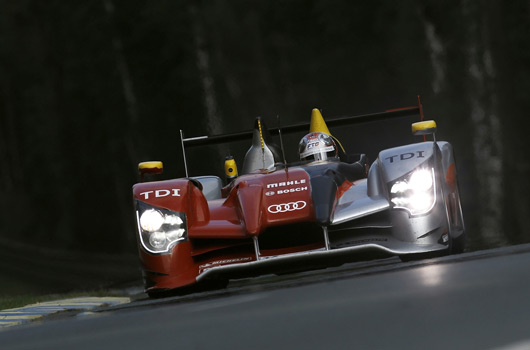
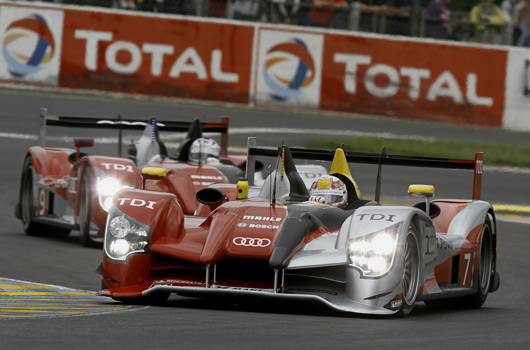
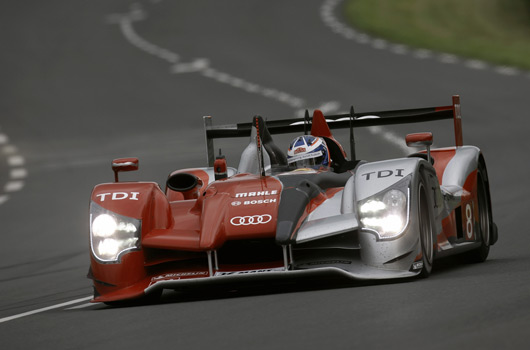
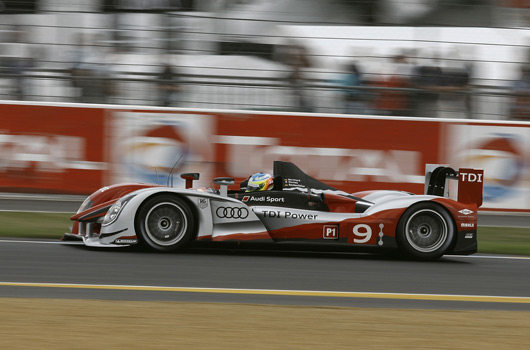
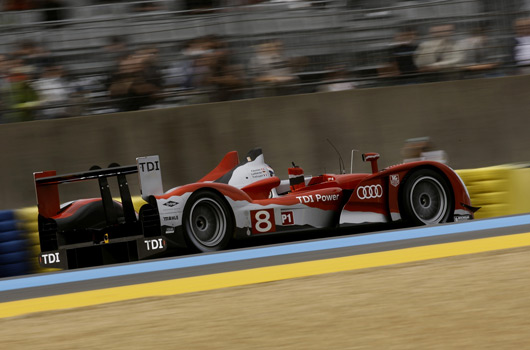
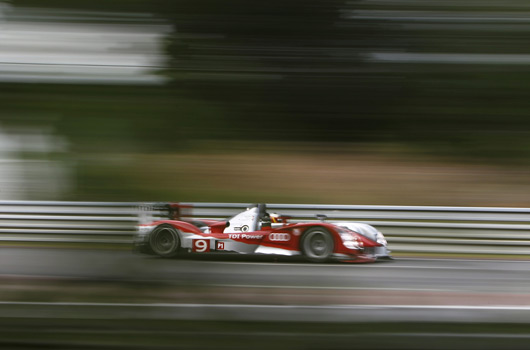
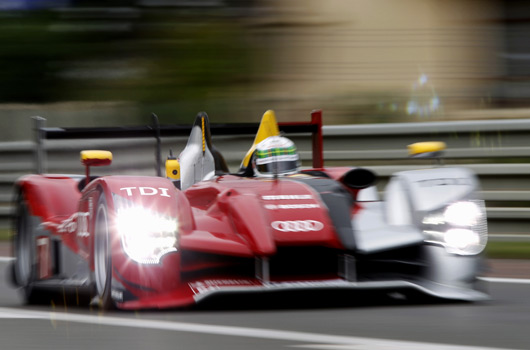
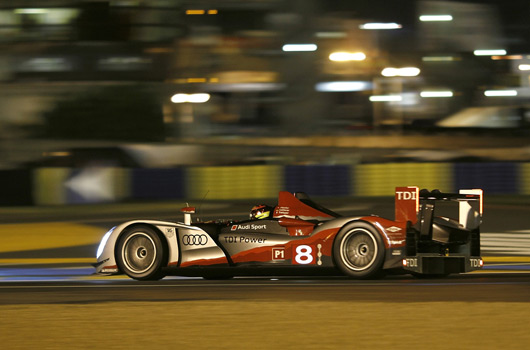
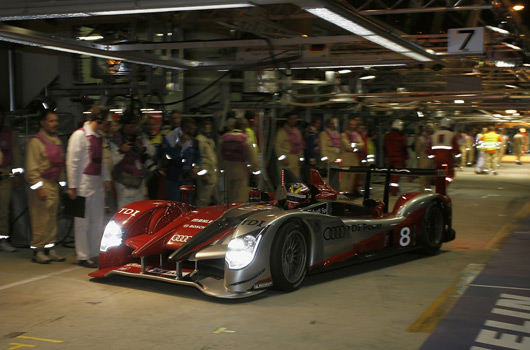
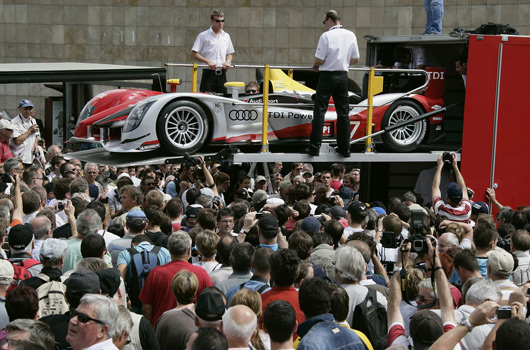
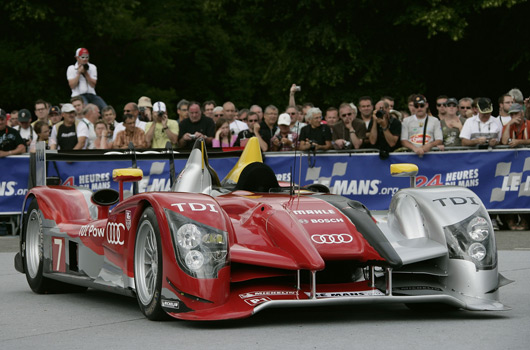
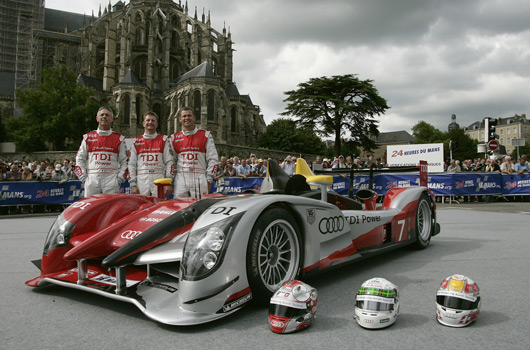
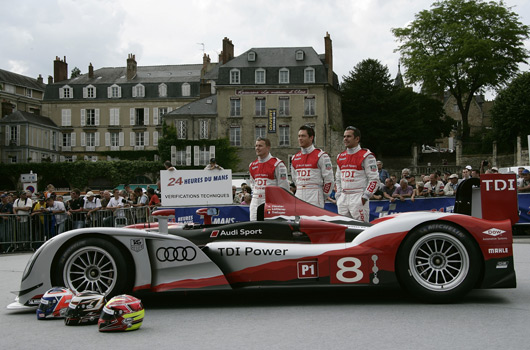
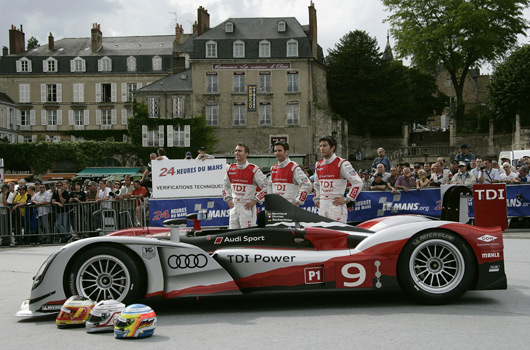
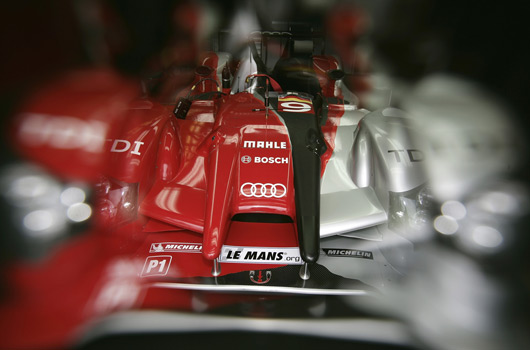
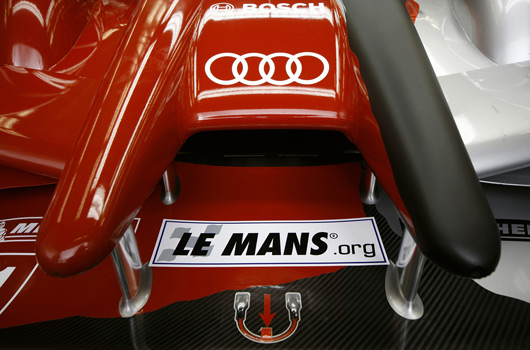
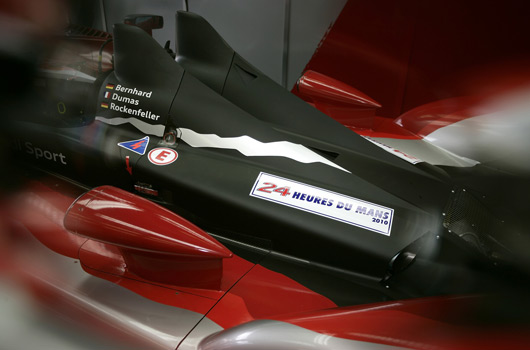
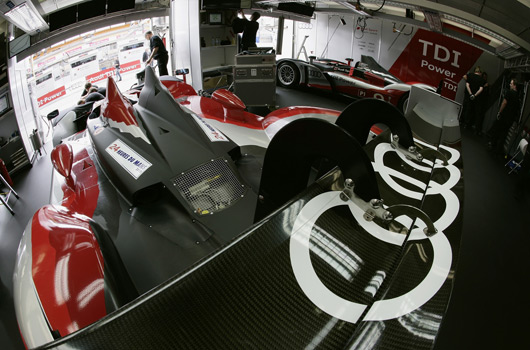
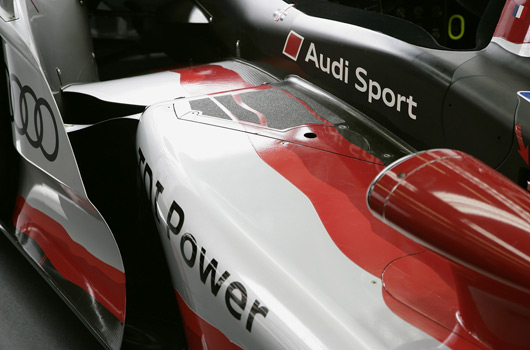
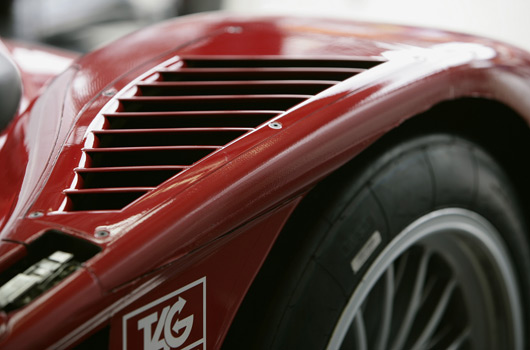
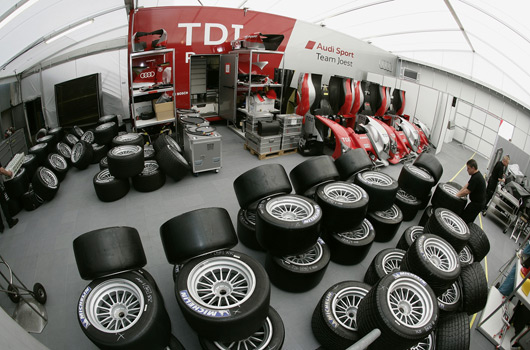
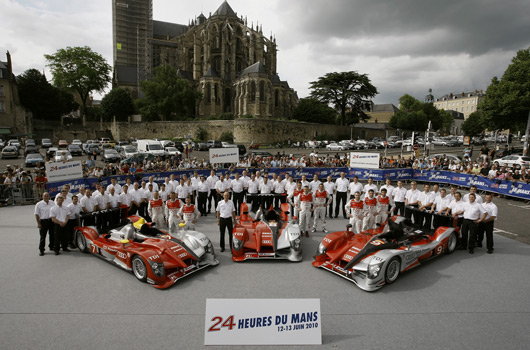
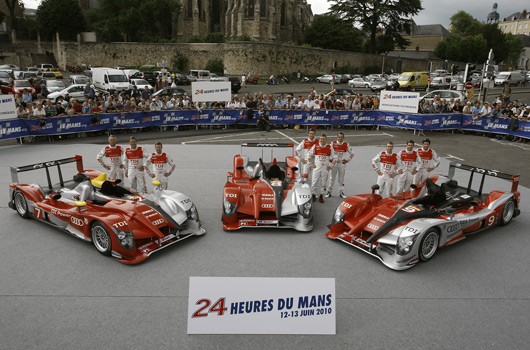
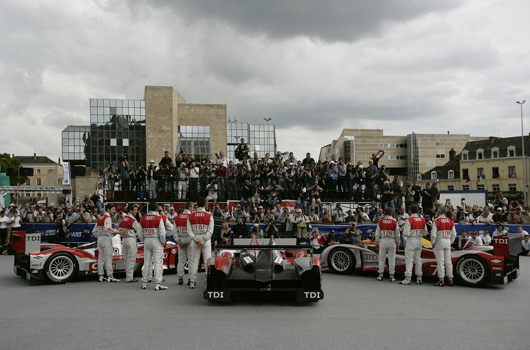
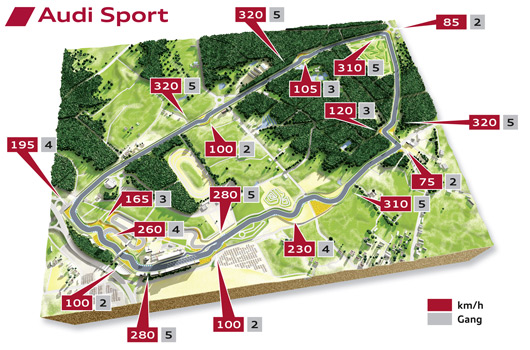
2 replies on “Audi pins hopes on efficiency for 2010 Le Mans assault”
Really awesome post. Honest.
The Audi R15 TDI Plus is beatiful. It is a Incomparable car!
” I love the Audi R15 TDI Plus “